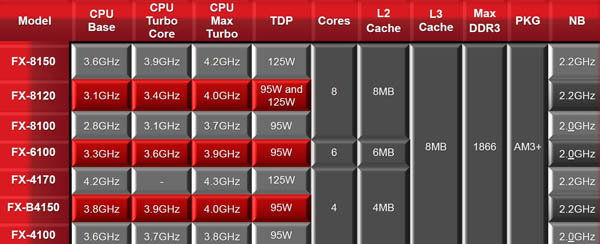The nuts and bolts
ISA improvements
Practically a given at any genuinely new CPU architecture launch, AMD's now supporting the Intel Advanced Vector Extensions (AVX), including hardware-based AES, which we've previously seen on the chip giant's Sandy Bridge processors. AMD accomplishes the required 256-bit FP operation by pairing the two aforementioned 128-bit FMACs.
Diverging a little away from Intel-led SSE optimisations, AMD integrates what's termed XOP and FMA4. These new instructions are what's left from SSE5. Too deep to go into in detail for this review, XOP and FMA4 enable the chip to streamline the compute of multi-operand instructions, but such is the to-and-fro between Intel and AMD relating to coding specifications, that the minnow, AMD, is having to redefine its own optimisations to be more in-line with Intel's. Have a read of this interesting article if you want a background primer.
Turbo Power play
AMD's also beefed-up the power-regulation for Bulldozer. Now, there's the possibility of power gating a module, using much the same APM process as on Llano. Gating enables a module to be effectively (electrically) switched off, saving expending unnecessary power. There's better RAM power management, says AMD, and more-efficient idling characteristics for Bulldozer's modules.
Going hand-in-hand with granular power support is a new revision to AMD's Turbo CORE overclocking. We've previously considered it clunky when compared to the fine-grained approach Intel has taken with Sandy Bridge, so AMD overhauled it for Bulldozer.
All cores can be Turbo CORE'd when there's TDP headroom on tap. This means that a 3.6GHz FX-8150 can push all cores up to 3.9GHz under the assumption that doing so doesn't breach the 125W TDP limits. The APM processor within the chip monitors the exact TDP and constantly adjusts the speed of the chip.
Further, should half, or fewer, cores be used in a particular application, the chip can run at what AMD terms Max CORE speed, which is 4.2GHz for the FX-8150. Achieving this higher speed is contingent upon non-working cores dropping into the power-frugal C6 state. As soon as they're needed and are thus woken up, clockspeed drops down.
AM3+
The revised power-management system requires a modified socket, says AMD. The reason for this rests with supplying Bulldozer chips with more current. Accordingly, motherboard partners have demonstrated the backwards-compatible AM3+ socket, showcased on 990FX chipset-based motherboards. Bulldozer and Thuban (Phenom II X6) are mechanically identical, indicating socket interoperability, and a clutch of motherboard partners have already certified a few presently-available AM3 boards, via a BIOS update, as 'Bulldozer-ready.'
Understand that 990FX chipset is practically identical to 890FX, save for increased current and official support for DDR3-1,866MHz speeds.
Yet chances are you will need a new motherboard if opting for the latest and greatest from AMD, though be sure to check for updates to any modern board before shelling hard-earned pennies. Buy a new Bulldozer CPU and 9-series motherboard and you'll have what AMD terms the Scorpius platform.
Architecture summary
Got all that? Nope? Well, let's distill it in a few words. AMD's new CPU-only Bulldozer uses two-core modules that are seamlessly joined together and represented as a single chip to the operating system. These modules can be harnessed to create eight-, six-, four-, and two-core chips. Each module has both independent and shared logic for the two cores, and AMD has architected such a chip to obtain the most bang-per-silicon buck for present and future workloads.
Newer instruction sets keep it up to date and further differentiate it from incumbent six-core Phenom II, while improved Turbo CORE and power gating brings efficiency to the fore. Now let's talk some pragmatism with real-world models.
Models - FX reborn

Here's an AMD-provided list of Bulldozer models that'll be made available from today onwards. The retail world doesn't adhere to codenames such as Bulldozer - more's the shame! - and AMD has made the bold decision to resurrect the FX nomenclature that's hither-to denoted supreme performance.
For once it's easy to see how AMD has cooked up the model numbers, where the first numerical value indicates number of cores and subsequent numbers the position of that processor within the same-core bracket. The deep pipeline enables AMD to ratchet the base speed up to Phenom II-beating levels, and the improved Turbo CORE is manifested in significant jumps over and above this base clock.
Let's dig into the fastest of the bunch, FX-8150. Shipping with guaranteed all-core frequency of 3.6GHz, it can, under ideal conditions, ramp up to 4.2GHz: heady stuff indeed. TDP is an industry-standard 125W, with the option of cheaper chips having dual TDPs - much like Phenom II. L2 cache is predicated on the number of modules present, but L3 is a standard 8MB. And, of course, all FX chips need an AM3+ form factor.
Pricing
Of the three chips for which the pricing has been disclosed, FX-8150 is likely to tip-up at $245, FX-8120 at $205, and FX-6100 at $165. What's more, all FX chips are multiplier-unlocked, meaning you can push up the frequency, by way of the multiplier, to your heart's and cooling's content. Such a move is interesting because it begs the question of why someone would proffer the additional $40 over and above the FX-8120, knowing both it and the '50 are unlocked?
But why has AMD priced what appears to be a powerhouse CPU - eight cores, 4.2GHz maximum speed, lots of cache - at such aggressive levels? The answer, dear reader, will be revealed as we expose the FX's Achilles Heel in our suite of benchmarks. Can you guess what it is yet? No? Read on.









